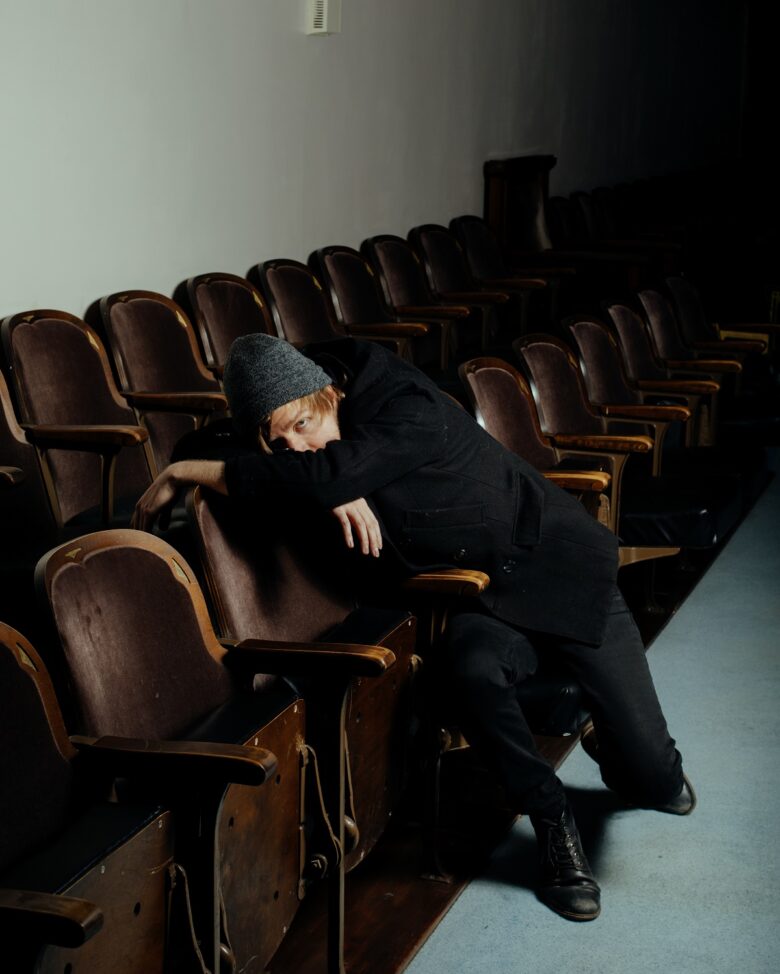“It’s going to be hard to talk about this when it’s done.”
So begins A Mold For The Bell, the new album from Colorado singer-songwriter and producer Logan Farmer, out October 14th via Western Vinyl. What follows that enigmatic lyric is a collection of stark and ambient folk songs, tethered solely by Farmer’s unadorned vocals, acoustic guitar and moving embellishments from contributors like saxophonist Joseph Shabason (who also mixed the album) and renowned harpist Mary Lattimore. Today, we release the first track, “Silence & Swell” is a dance between finger-picked acoustic guitar and a mournful saxophone solo from Shabason, in which Farmer asks quietly, “What are you afraid of, silence or swell?” Accompanied by the gorgeously moody video, Farmer explains: ” I wrote the opening line of Silence or Swell— ‘It’s gonna be hard to talk about this when it’s done’ — before I wrote anything else for the album. To me, it perfectly encapsulates the themes of A Mold For The Bell and sets the stage for everything that follows. But before that curtain lifts, you hear a field recording of people howling. That’s a thing that happened in Colorado and a few other places during those terrifying early months of the pandemic: every night at 8pm, people would go out into the street and howl at the moon. It became this bizarre nightly ritual full of camaraderie and defiance in the face of the unknown. Suffice to say, any feelings of unity fell apart soon after. Regardless, it was intriguing to me, so I recorded it on my phone. That howling appears a few times throughout the album as a kind of motif. The haunting sound, combined with the first lyric and Joseph Shabason’s sorrowful saxophone work, represent the spirit of A Mold For The Bell in my mind.
For the video, it was shot by Ben Ward and Matt Wade, alongside a small crew, during a cold spell last winter. It started with a simple concept that Ben and I came up with over beers a few months before: a plant monster in the back of a truck being driven to a bonfire where it’ll be sacrificed. Local artist Riley Furmanek designed and constructed the suit entirely from plant materials and clothes from a thrift store. I volunteered to be the person in the suit and got to walk around as a plant monster for a few days. We tried to keep everything as ambiguous as possible so it wasn’t too cheesy or sentimental with its environmental message. It turned out beautifully, thanks to everyone involved. It’s also worth emphasizing again how cold it was during filming. I was pretty comfortable in the suit, but everyone else in the cast and crew had to suffer a bit. They were all amazing throughout the whole process My job was easy, all I did was stagger around and try not to stand too close to the bonfire. That suit was like a tinderbox. “
With the help of Grammy-nominated producer Andrew Berlin (Gregory Alan Isakov), Farmer tracked all of the vocal and guitar parts over two days in the early months of 2021. The tracks were recorded quickly, live in the studio to capture the raw intimacy and immediacy of Farmer’s live performances. The rest of the album’s creation occurred remotely, over texts, phone calls and emails with Shabason and a handful of other musicians as wildfires, insurrections and the pandemic raged around them.
“I was working at a bookstore that winter,” Farmer explains, “and I’d walk to my shift every day, obsessing over lyrics and early mixes in a cheap pair of earbuds.” These daily walks would take him past a church, where he’d often stop on the sidewalk and listen to the bells at the top of the hour. “I’ve always loved the sound of church bells, but as the situation worsened, what began as a comfort began to feel ominous, almost threatening.”
This experience, alongside influences as disparate as Tarkovsky’s film Andrei Rublev and the novels of Olga Tokarczuk, led to a collection of songs that are similarly foreboding, expanding upon the stark and spacious universe of Farmer’s last album (2020’s Still No Mother) to reveal an atmosphere that’s even more oppressively still, like an abandoned Victorian home.
Unlike its predecessor, which was a personal exploration of Farmer’s climate anxiety, A Mold For The Bell reads like a collection of short stories, a series of disparate voices and doomed romances that seek dignity in a time of environmental and societal collapse. Lyrical imagery like bells, ruins, and archways appear repeatedly throughout the album, giving the impression that you’re overhearing a conversation, hushed and in confidence.
“I never wanted this, I never asked for this”
The music finishes and the listener is left without further explanation, an intruder in an empty home, as a field recording of church bells lingers in the distance.
Connect with Logan Farmer:
WEBSITE // INSTAGRAM // FACEBOOK// TWITTER



